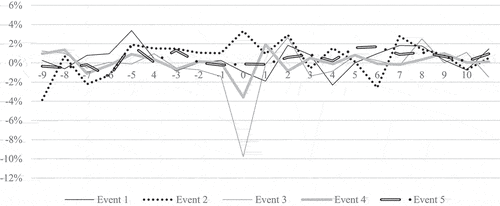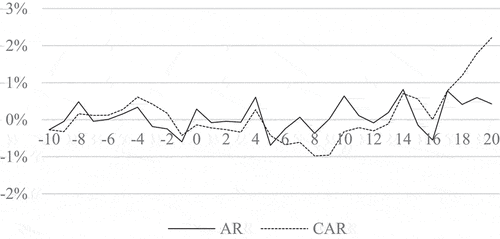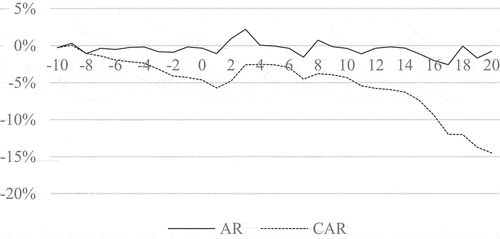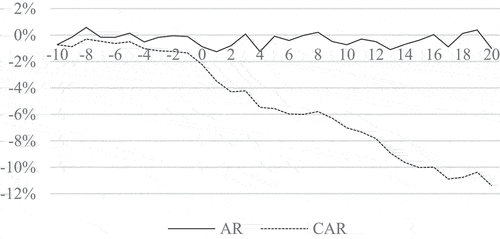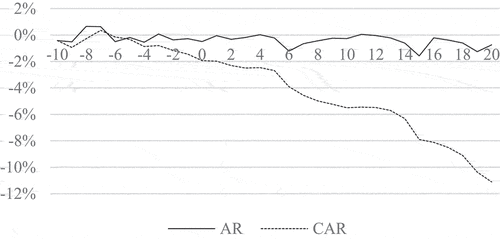 ?Mathematical formulae have been encoded as MathML and are displayed in this HTML version using MathJax in order to improve their display. Uncheck the box to turn MathJax off. This feature requires Javascript. Click on a formula to zoom.
?Mathematical formulae have been encoded as MathML and are displayed in this HTML version using MathJax in order to improve their display. Uncheck the box to turn MathJax off. This feature requires Javascript. Click on a formula to zoom.Abstract
This study explores the importance of central bank independence on stock market outcomes. Specifically, we examine the effects of President Recep Tayyip Erdogan’s decree, which removes the top officials of the Central Bank of Turkey, on Borsa Istanbul returns. We use a well-established event study methodology for five events from 20 July 2018, to 11 November 2021. The results show that the market is sensitive to the dismissal decrees in that they have positive effects on cumulative abnormal returns in the first two events, while the three events that follow have negative effects on cumulative abnormal returns. Our results support the importance of central bank independence, revealing that political intervention in central banks has a robust, positive, negative, and significant impact on stock market outcomes.
1. Introduction
On 6 July 2019, President Recep Tayyip Erdogan issued the first decree dismissing Central Bank of Turkey (CBT) governor Murat Cetinkaya without specifying the reason behind such action. In a speech delivered by President Erdogan in 8 December 2021, he said the following:
We certainly don’t believe in high interest rates. We will pull down inflation and exchange rates with low-rate policy … . High rates make the rich richer, the poor poorer. We won’t let that happen.
President Recep Tayyip ErdoganFootnote1
Media reports stated that the governor was fired because of his unwillingness to cut interest rates (Imbert, Citation2019). Since then, President Erdogan continued to interfere with central bank independence, removing several top CBT officials from their positions within a short period of time after disagreeing with their economic decisions.
Central bank independence is required to maintain economic stability and assist in rescues from financial crisis (Mishkin, Citation2004). It is usually measured through political and economic independence. Political independence refers to the central bank’s discretion in designing and implementing policies for monetary stability; it shields the central bank from short-term political pressures. In contrast, economic independence relates to the central bank’s freedom to choose a set of instruments consistent with monetary policy (Masciandaro & Romelli, Citation2015). This study investigates the relationship between central bank independence and stock market outcomes.Footnote2
The theoretical work of Ueda and Valencia (Citation2014) suggests that central bank independence is an important factor for economic stability. In the past few years, many countries have given monetary authorities more autonomy (Klomp & De Haan, Citation2010). According to Garcia and Costa (Citation2019), some features of the central bank, such as central bank independence and transparency in monetary policy-making, may influence stock market returns. A high degree of central bank’s independence may signal good governance to investors (Maxfield, Citation1997), an independent central bank’s monetary policy may limit budget deficits and, in turn, future expected taxes (Sargent & Wallace, Citation1981), and an independent central bank may promote stock market returns by limiting inflation (Fama & Schwert, Citation1977).
Empirical work shows that central bank independence affects exchange rates and sovereign bond yields (Kuttner & Posen, Citation2010; Moser & Dreher, Citation2010), inflation (Alesina and Summers, Citation1993; Anwar, Citation2022; Berger et al., Citation2001; Garriga & Rodriguez, Citation2020; Gyeke-Dako et al., Citation2022; Strong, Citation2021), and fiscal deficits (Agoba et al., Citation2019; Bodea & Hicks, Citation2015; Strong & Yayi, Citation2021). In terms of the impact of central bank independence on stock market returns, a limited number of papers have discussed this topic. For example, Förch and Sunde (Citation2012) study the emerging economies, where they find a positive impact of central bank independence on stock market returns. Kurihara et al. (Citation2012) also find a positive relationship between central bank independence and stock market returns. Garcia and Costa (Citation2019), in a study on the central bank independence in developed countries for a period of greater than 20 years, find that central bank independence positively affects stock market returns.
Using an event study methodology, this study explores the effects of the sacking of CBT top officials on Borsa Istanbul returns. What motivated us to conduct this study is the fact that we have a unique case of five changes of the officials of the central bank within a very short period of time. We believe such political interference will have a great influence on central bank independence and, in consequence, on stock market returns.Footnote3
Political intervention in central banks has in general, has a robust, negative, and significant impact on stock market outcomes. Such results support the importance of central bank independence. Thus, the implications of our study are important for politicians and investors to understand the effect of central bank independence on stock market outcomes.
The remainder of this paper is organized as follows: Section 2 provides the background of the events. Section 3 presents the data and methodology. Section 4 presents the descriptive statistics. Section 5 includes the results and discussion. Section 6 concludes the study.
2. Events background
The Turkish economy has suffered from an economic slowdown and rising inflation (Sonmez, Citation2022). Since 2019 up-to-date, the inflation rate has continued to increase in double digits. For example, it was 16.5% in 14 July 2019.0% in 16 November 2020.20% in 16 March 2021.60% in 19 May 2021.90% in October 2021 and 84.40% in November 2022.Footnote4 To protect the currency from further depreciation and to combat inflation, the central bank increased the one-week repo rate from 17.5% to 24% in September 2018, which was considered high and would impede economic expansion (BBC, Citation2019). From 6 July 2019, to 14 October 2021, President Erdogan issued multiple decrees dismissing and hiring several CBT officials, which provided an opportunity to test the following five events:
Event 1: On 6 July 2019, President Erdogan issued a decree dismissing CBT governor Murat Cetinkaya. According to Coskun (Citation2019), Mr. Cetinkaya refused to cut the interest rate by 300 basis points in June 2019. Following this decree, the Turkish lira dropped by 1.5% against the US dollar (Imbert, Citation2019).
Event 2: On 7 November 2020, Murat Uysal was dismissed from his position as CBT governor. He was sacked by President Erdogan without any reason being specified (Coskun et al., Citation2020). He had previously been Cetinkaya’s deputy and became CBT governor on 6 July 2019 (TRTWORLD, Citation2019).
Event 3: On 20 March 2021, Naci Agbal was dismissed from his position. He had previously been a finance minister and became the CBT governor on 7 November 2020 (Coskun et al., Citation2020). He was sacked by President Erdogan, who rejected the idea of increasing interest rates (Soylu, Citation2021). Naci Aqbal was fired two days after deciding to increase the interest rate (ALJAZEERA, Citation2021).
Event 4: On 25 May 2021, Oguzhan Ozbas was removed as deputy governor of the CBT. He was one of seven members of the rate-setting committee and had served as deputy governor since 30 August 2019 (Butler & Spicer, Citation2021).
Event 5: On 14 October 2021, President Erdogan dismissed Semih Tumen, Ugur Namik Kucuk, and Abdullah Yavas. Semih Tumen was an economic adviser to Erdogan (Ahval, Citation2021) and became the deputy governor on 25 May 2021. Semih Tumen, who worked previously as an economic adviser to Erdogan, filled Oguzhan Ozbas’ position (Ahval, Citation2021). Ugur Namik Kuck, a monetary policy committee member, was appointed as deputy governor on 14 August 2018. Abdullah Yavas, a monetary policy committee member, was appointed on 11 March 2008 (ALJAZEERA, Citation2021).
President Erdogan’s interference in the central bank’s decision concerning Turkey’s monetary policy provides a clue about the level of independence that the central bank enjoys because interference contradicts central bank Law No. 1211 in Turkey.Footnote5
3. Data and methodology
3.1. Data
Our sample represents daily data collected from Bloomberg from 20 July 2018, to 11 November 2021. When the removal decree is issued on a weekend, we consider the first trading day of the following week as the event day.Footnote6 The sample includes the adjusted closing prices of the Borsa Istanbul 100 Index (BIST100) and all stocks listed on Borsa Istanbul.
3.2. Methodology
We use a well-established event-study methodology. Event studies calculate the effect of a certain event on a firm’s value using information from the financial markets. The advantage of such a method comes from the fact that, in a rational market, the impact of an event will be quickly reflected in security prices. As a result, security prices observed over a relatively short time period can be used to provide a clear picture of the event’s economic impact (Mackinlay, Citation1997).
We calculate the daily return as follows:
where represents the daily rate of return for stock n,
is the natural logarithm,
is the price of stock n at time d, and
is the price of stock n at time
.
The daily abnormal returns and cumulative abnormal returns
in the observation period, including the event day (Day 0), are calculated using the market model. As in Dodd and Warner (Citation1983) and Brown and Warner (Citation1985), abnormal returns using the market model are calculated as follows:
where the dependent variable represents the daily abnormal returns for stock n at time d;
is the daily return for stock n at time d, as shown in EquationEq. 1
(1)
(1) ;
is the daily return of the BIST100;
is simply the summation of daily
s divided by the number of stocks N; and
and
indicate the regression coefficient estimates from the ordinary least squares method for the period [−250, −11] days.Footnote7
The advantage of this method is that it has a good predictive power and is widely used in the literature (Brenner, Citation1997). According to Armitage (Citation1995), the market model is the most reliable approach for calculating abnormal returns because as it consistently outperforms alternative estimation methods.
To determine the statistical significance of , we use the Satterthwaite–Welch t-test as our parametric test and the Wilcoxon–Mann–Whitney signed-rank median as our non-parametric test. According to Bartholdy et al. (Citation2011), Harris and Hardin (Citation2013), and Maynes and Rumsey (Citation1993), the median test is preferred when stocks are thinly traded and the sample size is small.
4. Descriptive statistics
Figure (B1–B5) show the patterns and
. All figures suggest negative
and
values surrounding the events.
The descriptive statistics in Table and Table show that events have a negative effect on our sample. Table shows the mean and median for the of the five events included in our study. For all five events, both the mean and the median
are negative on the event day (Day 0), except for Event 2.
Table shows the mean and median for the for the five events. For all five events, both the mean and the median
are negative on the event day (Day 0).
5. Results and discussion
The market model results show that dismissal decisions have a significant impact on stock market returns. The mean and median equality tests results in Table show the effects of dismissal decisions on .
Table presents the results of the mean and median equality tests for Event 1. The mean equality tests in Panel A of Table suggest a significant negative market reaction for the first dismissal decision in the event window [−5, 5]. However, the event window [−10, 20] shows a significant positive market reaction. The median equality tests in Panel B of Table suggest a significant negative market reaction for the first dismissal decision in the event window [−5, 5]. However, the event windows [−10, 15] and [−10, 20] show a significant positive market reaction.Footnote8
Table presents the results of the mean and median equality tests for Event 2. The mean and median equality tests in Panels A and B of Table suggest insignificant reactions for early event window days. However, the event window [−10, 20] shows a significant positive market reaction for both the mean and the median equality tests.
The results of the mean and median equality tests for Event 3 in Table suggest a significant negative market reaction for both mean and median equality tests for event windows [−10, 10], [−10, 15], and [−10, 20].
The results of the mean and median equality tests for Events 4 and 5 in Table , respectively, suggest a significant negative market reaction for both mean and median equality tests for all event windows.
In general, we find mixed results for the first two events and a clear negative significant effect for the last three events. One possible explanation for the mixed results of the first two events is that in a Muslim-majority country such as Turkey, speeches by President Erdogan to fight interest rate hikes may have sent a positive signal to some Islamic investors. However, his continuous intervention in the CBT has sent a clear message to investors about the lack of economic stability. In the later events (Events 3, 4, and 5), it is clear that the political intervention of removing central bank leaders has a robust, negative, and significant impact on stock market returns.
The findings mainly support recent contributions to the literature on the effects of central bank independence on market outcomes, which have found that market performance seems to be improved by central bank independence. There is quantitative significance to the impacts. A high degree of central bank independence may signal good governance to investors (Maxfield, Citation1997), and an independent central bank may promote stock market returns by limiting inflation (Fama & Schwert, Citation1977). To determine the mechanisms by which central banks influence stock market returns, more research is required.
6. Conclusion
This study investigates the importance of central bank independence on stock market stability. We examine how President Erdogan’s dismissal decisions to remove top CBT officials affected Borsa Istanbul returns, using daily data from Borsa Istanbul from 20 July 2018, to 11 November 2021.
Employing event study methodology, we find that these decisions have positive and negative effects on stock market returns. Specifically, we find that the first two dismissal decrees have positive outcomes on cumulative abnormal returns; however, the last three events have negative effects on cumulative abnormal returns.
Our results support the importance of central bank independence, revealing that political intervention in central banks has a robust, positive, negative, and significant impact on stock market outcomes.
Disclosure statement
No potential conflict of interest was reported by the author(s).
Additional information
Funding
Notes
1. As quoted by Firat Kozok (8 December 2021). https://www.bloomberg.com/news/articles/2021-12-08/erdogan-urges-central-bank-to-keep-going-on-interest-rate-cuts
2. Other studies have investigated the determinants of the stock market returns. For example, Demier (Citation2019) studies the effect of some macroeconomic variables on the Borsa Istanbul 100 index. He finds that economic growth, the relative value of the domestic currency, portfolio investments and foreign direct investments positively affect the BIST100 whereas interest rates and crude oil prices negatively affect the index. In addition, Acikalin et al. (Citation2008) find that GDP, exchange rate, and current account balance negatively affect the BIST100. These studies differ from our paper, in that our focus here is on the relationship between central bank independence and stock market returns. Researchers interested in such topics—the determinants of stock market returns—can investigate it in more detail in a future research by employing different economic variables in their econometric model.
3. The figure in Appendix 1 shows the significant impact of the events on the Borsa Istanbul 100 Index Returns (BIST100).
4. Inflation rates kept accelerating until very recently. The mentioned dates are associated with the dismissal dates of the officials. These rates are year-over-year inflation rates (compared with the same month in the previous year). Data obtained from https://ycharts.com/indicators/turkey_inflation_rate#:~:text=Turkey%20Inflation%20Rate%20is%20at,long%20term%20average%20of%2025.67%25.
5. Article 4 states “the bank shall enjoy absolute autonomy in exercising the powers and carrying out the duties granted by this Law under its own responsibility”.
6. For example, Murat Cetinkaya was removed on Saturday 6 July 2019, and the stock market was closed on that day. Thus, we consider the first trading day of the week, that is, Monday 8 July 2019, as the event day. The same treatment is applied for events 2 and 3.
7. The −250 is selected to roughly match the number of trading days in a calendar year. It represents a period before the event day that is lengthy enough to allow accurate estimation of the parameters of the selected return-generating mechanism.
8. We follow Kolaric and Schiereck (Citation2016) and Bash and Alsaifi (Citation2019) in choosing the event windows [−1, 1], [−3, 3], [−5, 5], [−10, 10], [−10, 15], [−10, 20]. They are arbitrarily chosen and widely employed in the event-studies.
References
- Acikalin, S., Aktas, R., & Unal, S. (2008). Relationships between stock markets and macroeconomic variables: An empirical analysis of the Istanbul Exchange. Investment Management and Financial Innovation, 5(1), 8–15. https://www.businessperspectives.org/images/pdf/applications/publishing/templates/article/assets/2050/imfi_en_2008_01_Acikalin.pdf
- Agoba, A., Abor, J., Osei, K., Sa-Aadu, J., Amoah, B., & Dzeha, G. (2019). Central bank Independence, elections and fiscal policy in Africa: Examining the moderating role of political institutions. International Journal of Emerging Markets, 14(5), 809–830. https://doi.org/10.1108/IJOEM-08-2018-0423
- Ahval. (2021) Erdogan sacks central bank’s deputy chief in management overhaul. Source: Ahval https://ahvalnews.com/turkish-lira/erdogan-sacks-central-banks-deputy-chief-management-overhaul
- Alesina, A., & Summers, L. (1993). Central bank independence and macroeconomic performance: Some comparative evidence. Journal of Money, Credit, and Banking, 25(2), 151. https://doi.org/10.2307/2077833
- ALJAZEERA. (2021) Turkey removes another Central Bank deputy governor. Source: ALJAZEERA https://www.aljazeera.com/economy/2021/5/25/turkey-removes-one-more-central-bank-deputy-governor
- Anwar, C. (2022). Heterogeneity effect of central bank independence on inflation in developing countries. Global Journal of Emerging Market Economies.
- Armitage, S. (1995). Event study methods and evidence on their performance. Journal of Economic Surveys, 9(1), 25–52. https://doi.org/10.1111/j.1467-6419.1995.tb00109.x
- Bartholdy, J., Olsen, D., & Peare, P. (2011). Conducting event studies on a small stock exchange. European Journal of Finance, 13(3), 227–252. https://doi.org/10.1080/13518470600880176
- Bash, A., & Alsaifi, K. (2019). Fear from uncertainty: An event study of Khashoggi and stock market returns. Journal of Behavioural and Experimental Finance, (23), 54–58. https://doi.org/10.1016/j.jbef.2019.05.004
- BBC. (2019) Turkey’s Erdogan fires central bank chief Murat Cetinkaya. https://www.bbc.com/news/world-europe-48891658
- Berger, H., De Haan, J., & Eijffinger, S. (2001). Central bank Independence: An update of theory and evidence. Journal of Economic Surveys, 15(1), 3–40. https://doi.org/10.1111/1467-6419.00131
- Bodea, C., & Hicks, R. (2015). Price stability and central bank Independence: Discipline, credibility, and democratic institutions. International Organization, 69(1), 35–61. https://doi.org/10.1017/S0020818314000277
- Brenner, M. (1997). The sensitivity of the efficient market hypothesis to alternative specifications of the market model. Journal of Finance, 34(4), 915–929. https://doi.org/10.1111/j.1540-6261.1979.tb03444.x
- Brown, S., & Warner, J. (1985). Using daily stock returns: The case of event studies. Journal of Financial Economics, 14(1), 3–31. https://doi.org/10.1016/0304-405X(85)
- Butler, D., & Spicer, J. (2021) Factbox: Revolving door: Personnel changes at Turkey’s central bank: Source. Reuters. https://www.reuters.com/world/middle-east/revolving-door-personnel-changes-turkeys-central-bank-2021-10-14/
- Coskun, O. (2019) Turkey’s central bank governor was sacked after resisting 300-point rate cut: Sources. Reuters. https://www.reuters.com/article/us-turkey-cenbank-governor/turkeys-central-bank-governor-was-sacked-after-resisting-300-point-rate-cut-sources-idUSKCN1UH142
- Coskun, O., Devranoglu, N., & Butler, D. (2020) Turkey’s Erdogan ousts central bank governor after steep lira slide: Source. Reuters. https://www.reuters.com/article/uk-turkey-cenbank-governor-idUSKBN27N025
- Demier, C. (2019). Macroeconomic determinants of stock market Fluctuations. The case of BIST-100. Economies, 7(1), 8. https://doi.org/10.3390/economies7010008
- Dodd, P., & Warner, J. (1983). On corporate governance: A study of proxy content. Journal of Financial Economics, 11(1–4), 401–438. https://doi.org/10.1016/0304-405X(83)
- Fama, E., & Schwert, G. (1977). Asset returns and inflation. Journal of Financial Economics, 5(2), 115–146. https://doi.org/10.1016/0304-405X(77)90014-9
- Förch, T., & Sunde, U. (2012). Central bank Independence and stock market returns in emerging economies. Economics Letters, 115(1), 77–80. https://doi.org/10.1016/j.econlet.2011.11.030
- Garcia, M., & Costa, P. (2019). Central bank Independence and stock market returns in developed countries. International Review of Applied Economics, 33(3), 335–352. https://doi.org/10.1080/02692171.2018.1493093
- Garriga, A., & Rodriguez, C. (2020). More effective than we thought: Central bank Independence and inflation in developing countries. Economic Modelling, 85, 87–105. https://doi.org/10.1016/j.econmod.2019.05.009
- Gyeke-Dako, A., Agbloyor, E., Agoba, A., Turkson, F., & Abbey, E. (2022). Central Bank Independence, Inflation, and Poverty in Africa. Journal of Emerging Market Finance, 21(2), 211–236. https://doi.org/10.1177/09726527221078434
- Harris, T., & Hardin, J. (2013). Exact Wilcoxon signed-rank and Wilcoxon Mann–Whitney ranksum tests. The Stata Journal, 13(2), 337–343. https://doi.org/10.1177/1536867X1301300208
- Imbert, F. (2019) Turkish currency and stocks drop after President Erdogan fires top central bank official. CNBC. https://www.cnbc.com/2019/07/08/turkish-currency-and-stocks-drop-after-president-erdogan-fires-top-central-bank-official.html
- Klomp, J., & De Haan, J. (2010). Inflation and central bank Independence: A meta‐regression analysis. Journal of Economic Surveys, 24(4), 593–621. https://doi.org/10.1111/j.1467-6419.2009.00597.x
- Kolaric, S., & Schiereck, D. (2016). Are stock markets efficient in the face of fear? Evidence from the terrorist attacks in Paris and Brussels. Finance Research Letters, 18, 306–310. https://doi.org/10.1016/j.frl.2016.05.003
- Kozok, F. (2021) Erdogan Urges Central Bank to Keep Going on Interest Rate Cuts. Bloomberg. https://www.bloomberg.com/news/articles/2021-12-08/erdogan-urges-central-bank-to-keep-going-on-interest-rate-cuts#xj4y7vzkg
- Kurihara, Y., Morikawa, K., & Takaya, S. (2012). Central Bank’s Independence and Stock Prices. Modern Economy, 3(6), 793–797. https://doi.org/10.4236/me.2012.36101
- Kuttner, K., & Posen, A. (2010). Do Markets Care Who Chairs the Central Bank? Journal of Money, Credit, and Banking, 42(2–3), 347–371. https://doi.org/10.3386/w13101
- Mackinlay, A. C. (1997). Event studies in Economics and Finance. Journal of Economic Literature, 35(1), 13–39. https://www.jstor.org/stable/2729691
- Masciandaro, D., & Romelli, D. (2015). Ups and downs of central bank Independence from the Great Inflation to the Great Recession: Theory, institutions and empirics. Financial History Review, 22(3), 259–289. https://doi.org/10.1017/S0968565015000177
- Maxfield, S. (1997). Gatekeepers of Growth: The International Political Economy of Central Banking in Developing Countries. Princeton University Press.
- Maynes, E., & Rumsey, J. (1993). Conducting event studies with thinly traded stocks. Journal of Banking & Finance, 17(1), 145–157. https://doi.org/10.1016/0378-4266(93)
- Mishkin, F. (2004) Can Inflation targeting work in emerging market countries? NBER Working Paper. 10646. https://www.nber.org/papers/w10646
- Moser, C., & Dreher, A. (2010). Do markets care about central bank governor changes? Evidence from emerging markets. Journal of Money, Credit, and Banking, 42(8), 1589–1612. https://doi.org/10.1111/j.1538-4616.2010.00355.x
- Sargent, T., & Wallace, N. (1981). Some unpleasant monetarist arithmetic. Federal Reserve Bank of Minneapolis Quarterly Review, 5(1), 1–17. https://ideas.repec.org/a/fip/fedmqr/y1981ifallnv.5no.3.html
- Sonmez, M. (2022) Turkey’s inflation hits almost 80% as Erdogan insists on low-rate policy. AL-MONITOR. https://www.al-monitor.com/originals/2022/08/turkeys-inflation-hits-almost-80-erdogan-insists-low-rate-policy
- Soylu, R. (2021) Why Erdogan fired Turkey’s central bank governor. MIDDLE EAST EYE. https://www.middleeasteye.net/news/turkey-central-bank-chief-fired-why
- Strong, C. (2021). Political influence, central bank Independence and inflation in Africa: A comparative analysis. European Journal of Political Economy, 69, 102004. https://doi.org/10.1016/j.ejpoleco.2021.102004
- Strong, C., & Yayi, C. (2021). Central bank Independence, fiscal deficits and currency union: Lessons from Africa. Journal of Macroeconomics, 68, 103313. https://doi.org/10.1016/j.jmacro.2021.103313
- TRTWORLD. (2019) Murat Uysal is Turkey’s new central bank governor. Source: TWTWORLD https://www.trtworld.com/turkey/murat-uysal-is-turkey-s-new-central-bank-governor-28044
- Ueda, K., & Valencia, F. (2014). Central bank Independence and macro-prudential regulation. Economics Letters, 125(2), 327–330. https://doi.org/10.1016/j.econlet.2013.12.038
Appendix A
Appendix B
Appendix C
Table C1. Descriptive Statistics for Abnormal Returns () for the Five Events
Table C2. Descriptive Statistics for Cumulative Abnormal Returns () for the Five Events
Table C3. Event 1 Mean and Median Equality Tests for Cumulative Abnormal Returns : Market Model Following Event 1
Table C4. Event 2 Mean and Median Equality Tests for Cumulative Abnormal Returns : Market Model Following Event 2
Table C5. Event 3 Mean and Median Equality Tests for Cumulative Abnormal Returns : Market Model Following Event 3
Table C6. Event 4 Mean and Median Equality Tests for Cumulative Abnormal Returns : Market Model Following Event 4
Table C7. Event 5 Mean and Median Equality Tests for Cumulative Abnormal Returns : Market Model Following Event 5

